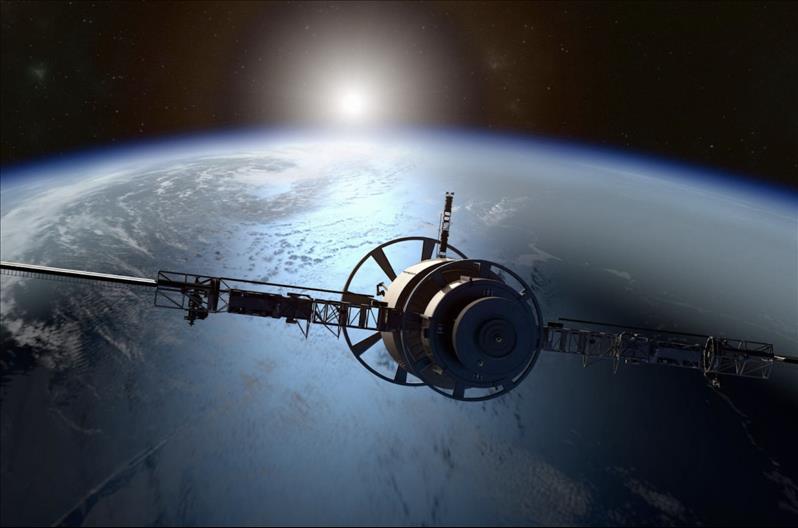
US, China In Crucial Race To Put Spying Eyes In The Sky
The US Space Force (USSF) and National Reconnaissance Office (NRO) plan to build several targeting satellites to launch into Low-Earth Orbit (LEO) as part of an ongoing push to increase satellites for intelligence and military targeting purposes.
Air & Space Forces Magazine reported this month that the satellites will provide Moving Target Indication (MTI), helping troops on the ground or in air tracking targets. They are scheduled to replace old US Air Force aircraft that officials say would not survive in a contested environment.
Vice Chief of Space Operations for Intelligence Major General Gregory Gagnon did not specify in the article how many satellites would be needed or when they would launch.
However, he did lay out the basic framework for how they would work and how USSF Guardians would use them to assist combatant commanders around the globe, as stated by the source.
Air & Space Forces Magazine notes that the USSF is already building proliferated constellations for transporting data and LEO missile warning and tracking.
The hope is that a potential adversary won't be able to shoot down enough satellites to disrupt the network, thus deterring it from trying in the first place.
The report points out that the USSF will likely have to buy dozens of small satellites to have such a targeting solution, as spacecraft in LEO don't stay in one place, and it takes several to provide steady, persistent coverage over an area.
Satellites offer advantages over reconnaissance aircraft. In September 2023, Asia Times noted that the US plans to move significant intelligence, surveillance and reconnaissance (ISR) capabilities from planes to satellites.
Compared to aircraft, satellites are less expensive to operate, do not require large support crews and are less vulnerable to long-range missiles.
Countries with space-based ISR have a lower risk of invasion and surprise attacks. Espionage in space is difficult to conceal and attacking spy satellites could lead to conflict.

Global auditions are changing the 'K' in K-pop

The Indian middle class doesn't need a savior

How Ukraine has resisted Russia's cyber offensive
However, satellites also have many vulnerabilities such as cyberattacks, high launch and replacement costs, anti-satellite (ASAT) weapons and space debris.
The proliferation of space-based ISR capabilities to US near-peer adversaries and rogue states is also a threat.
The Warzone reported in March 2024 that the NRO is acquiring a constellation of hundreds of ISR satellites from SpaceX that focus on tracking targets for ground operations.
The Warzone says the project resembles the USSF's highly classified space-based radar surveillance program. It mentions that SpaceX's government sales-focused business unit, Starshield, is working on the new LEO spy satellites under a US$1.8 billion contract received in 2021 from NRO.
The constellation's operational start date is unclear but SpaceX has been launching relevant prototype satellites since 2020. The satellites will have Earth-imaging capabilities and can operate in a swarm.
They will most likely have Ground Moving Target Indicator (GMTI) and Synthetic Aperture Radar (SAR) capabilities, which could help track ground-mobile ballistic missile launchers used by Russia and China.
The advantage of this kind of radar is that it provides constant coverage and imagery, penetrating cloud cover even during night hours.
The Warzone notes that a network of spy satellites could provide continuous coverage of Earth and make it harder for adversaries to hide activities.
Machine learning and AI can help find targets faster, while autonomous collection and tasking can be achieved. A distributed constellation of satellites would also be more resilient to hostile attacks.
Not to be outdone, Defense One reported this month that China is breaking the US monopoly on satellite-based long-range targeting by building a massive architecture of remote-sensing satellites to help target US forces deployed to defend Taiwan in a conflict.
Defense One notes that China has launched over 400 satellites in the past two years, with more than half designed for Earth observation and surveillance in the Western Pacific. The country has seen a 550% increase in on-orbit assets since the inception of its military space arm in 2015 .
Illustrating China's advances in surveillance satellite technology, Defense One mentions that last year China launched Ludi Tance-4, the world's first geosynchronous orbit (GEO) satellite with a SAR payload.
Satellite operators need the ability to quickly deploy and replace disabled, damaged, or old satellites to provide essential space-based services such as communication, ISR and targeting.
In line with that, Asia Times noted in March 2024 that China may have surpassed the US
in its ability to quickly replace damaged or destroyed satellites during a conflict, a process known as tactically responsive space launch (TRSL).
Contrasting US and Chinese satellite launch approaches may have led to this situation. US satellite capabilities focus on payload capacity, reliability and efficiency in deploying as many satellites as possible in one launch.
This approach has led to the development of large, liquid-fueled rockets that require complex positioning and fueling processes and advanced ground support equipment.
In contrast, China has focused on developing mobile, solid-fuel rockets that do not need complex launch infrastructure. While these smaller rockets cannot carry as many satellites as their liquid-fuel counterparts, they can launch from remote locations, making them ideal for replacing damaged or destroyed satellites.
The US and China are both tapping into their commercial space sectors to bolster space-based ISR and targeting capabilities, albeit with different approaches.

Sign up for one of our free newsletters
- The Daily ReportStart your day right with Asia Times' top stories AT Weekly ReportA weekly roundup of Asia Times' most-read stories
In June 2022, Andrew Erickson noted that China's military-civil fusion (MCF) strategy emphasizes dual-use technologies such as satellites for military use.
The People's Liberation Army-Strategic Support Force (PLA-SSF), now the Information Support Force (PLA-ISF) , is known to have partnered with Chinese commercial space firms.
Furthermore, in a November 2023 article for The Strategist , Ashley Lin notes that China's civilian space agencies will be integrated into its military ISR capabilities in wartime.
China views such capabilities as decisive in future high-intensity conflicts, especially in a Taiwan invasion. Recently, China's commercial Taijing 4-03 SAR satellite took highly detailed photos of US Naval Base Norfolk along with US carriers and warships , highlighting its potential targeting capabilities.
Perhaps borrowing a page from China's MCF strategy, Overt Defense reported last month that the US Department of Defense (DOD) released its first strategy to integrate commercial space capabilities, emphasizing collaboration and technological advancements.
The document outlines a balance of government and commercial solutions, interoperability, resilience and adherence to international norms and standards in space.
Overt Defense notes that following the DOD, the USSF released a more detailed strategy specifying minimum capabilities to be acquired through commercial partnerships.
The USSF
seeks broad surveillance services and analytic capabilities from the commercial sector to support its Tactical Surveillance, Reconnaissance and Tracking (TacSRT) needs.
Thank you for registering!
An account was already registered with this email. Please check your inbox for an authentication link.

Legal Disclaimer:
MENAFN provides the
information “as is” without warranty of any kind. We do not accept
any responsibility or liability for the accuracy, content, images,
videos, licenses, completeness, legality, or reliability of the information
contained in this article. If you have any complaints or copyright
issues related to this article, kindly contact the provider above.


















Comments
No comment